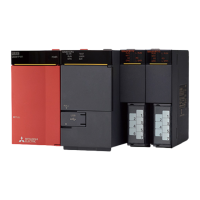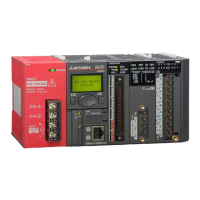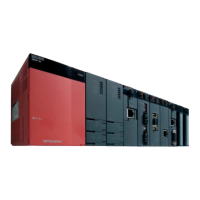7 APPLICATION INSTRUCTION
7.5 Data table operation instruction
357
7
Inserting data to the data table
FINS(P)
These instructions insert 16-bit data specified by (s) to the data table specified by (d) as the (n)th data.
After these instructions are executed, the data after the (n)th data in the data table is moved down by one data point.
■Descriptions, ranges, and data types
■Applicable devices
• These instructions insert 16-bit binary data specified by (s) to the data table specified by (d) as the (n)th data. After these
instructions are executed, the data after the (n)th data in the data table is moved down by one data point.
• The device range used in a data table should be controlled by the user.
• The data table has (d) number of stored data starting from ((d)+1).
Ladder diagram Structured text
ENO:=FINS(EN,s,n,d);
ENO:=FINSP(EN,s,n,d);
Operand Description Range Data type Data type (label)
(s) Head device number where the insertion-target data is stored 16-bit signed binary ANY16
(d) Start number of the table Word ANY16
(n) Data insertion position in the table 1 to 32767 16-bit unsigned binary ANY16
Operand Bit Word Double word Indirect
specification
Constant Others
X, Y, M, L,
SM, F, B, SB
U\G T, ST,
C, LC
T, ST, C, D,
W, SD, SW, R
U\G Z LC LZ K, H E $
(s)
(d)
(n)
When 2 is set in (n), the data is inserted
in (d)+2.
(d)+1
(d)+2
(d)+3
(d)+4
(d)+5
(d)
(s)
(d)+1
(d)+2
(d)+3
(d)+5
(d)+4
(d)
5432
1234
3
-123
0
0
4444
0
5432
4444
4
1234
-123
0
0
Data table
Data table
Data table range
Number of stored data

